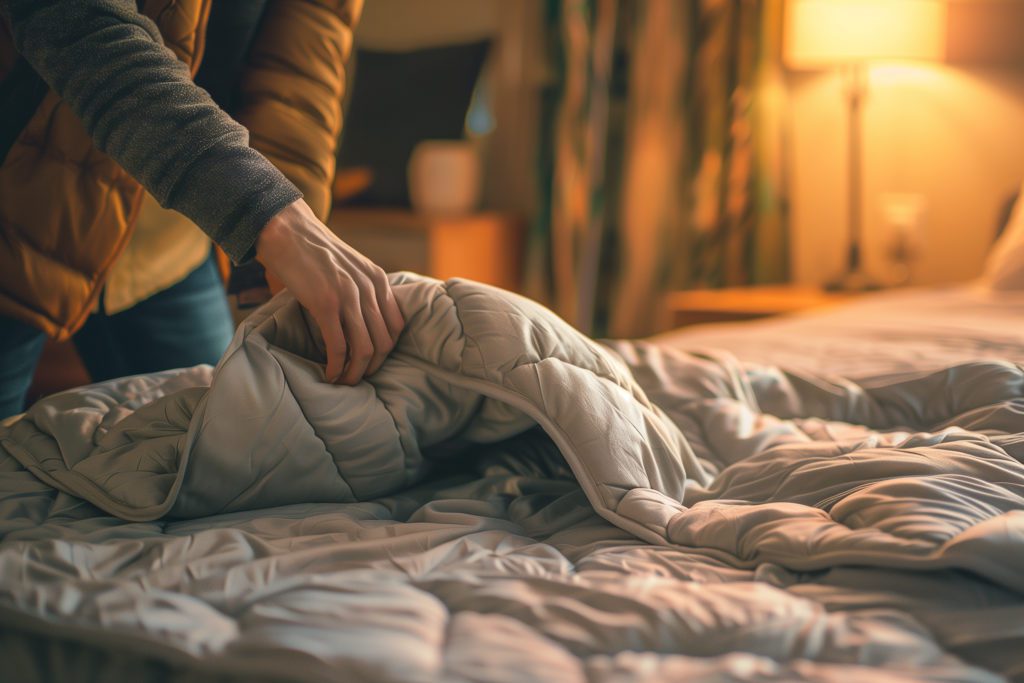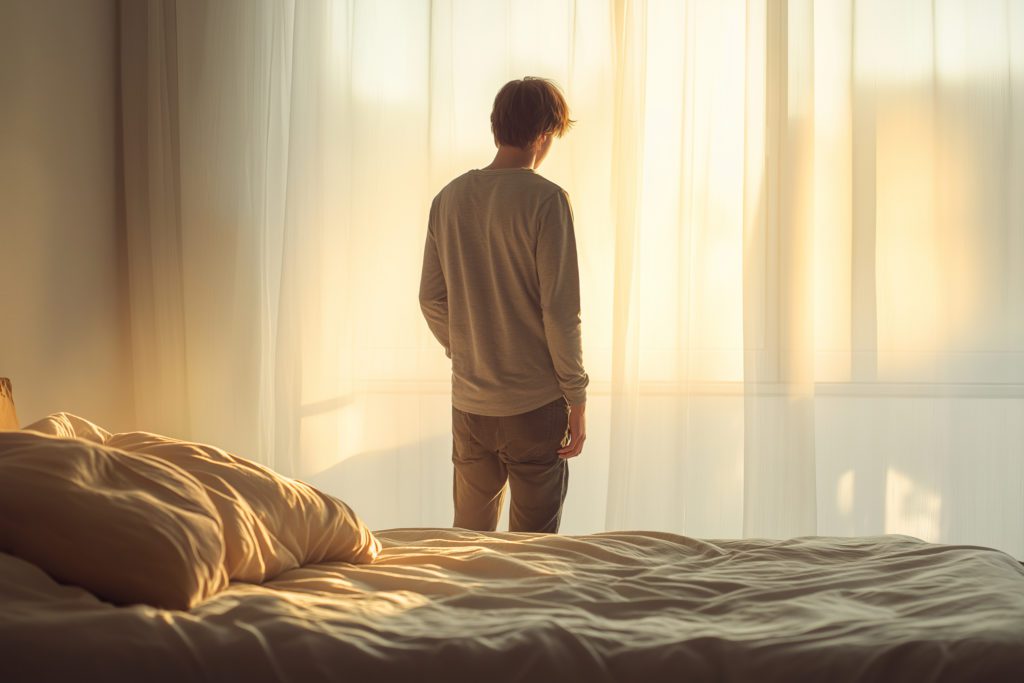
A Sleepwalker’s Guide to Somnambulism
Ever found yourself in the kitchen at 3 AM, not sure how you got there? You could be experiencing somnambulism. More insights inside.

Let's talk about sleepwalking, or somnambulism if you want to get technical. It seems almost cartoonish—picturing someone in PJs, tiptoeing around the house while fast asleep. Funny, right?
Well, not so much if it's you or someone you know. Beyond the chuckles and the "weird" stories lies a complex condition that's more common and serious than most of us think.
Here, we're exploring the why's and how's of sleepwalking. From what triggers those unexpected night hikes to figuring out if those trips to the fridge while asleep mean something more. Stick with us as we decode somnambulism, making it less of an oddity and more of something we can understand and manage.
Sleepwalking is more than just a midnight stroll
So, what's the deal with sleepwalking? It's not just getting up and walking around; it's a full-blown sleep disorder where folks do a range of things—from simple walking to complex tasks—all while catching Z's. And no, it's not the same as those vivid dreams or night terrors. Sleepwalking is in its own league, happening during the deepest part of sleep when dreaming's not even on the agenda.
You might think sleepwalking is uncommon or something only kids go through. However, it's actually more widespread. According to research, while it's true that sleepwalking peaks in childhood, affecting 5-15% of kids, adults are not exempt. Indeed, 1-1.5% of adults also experience sleepwalking episodes, showing that these nocturnal wanderings aren't just child's play.
It's a whole spectrum, from the occasional wanderer to those who turn it into a nightly habit. Understanding this can change the game, turning sleepwalking from a mystery into something we can get a handle on, whether it's happening to you, a little one, or your roommate who keeps raiding the fridge at 2 AM.
What sparks somnambulism, a.k.a. sleepwalking?
Getting to grips with why people sleepwalk feels a bit like detective work. There's not one clear culprit but a mix of suspects.
Genetics play a big part, with research showing that up to 80% of sleepwalking cases in men and 36% in women are attributed to them. This means that if your family tree has sleepwalkers, there's a higher chance you might take a few midnight tours yourself.
Then there's the environment and lifestyle—things like stress, lack of sleep, and even a noisy bedroom can set the stage for a sleepwalking scene. It's like your brain's way of acting out when it's not getting the rest it needs or when it's overloaded.
Medications and substances add another layer to the mystery. Some meds, especially those for sleep or mental health, can have the unexpected side effect of leading you on a nocturnal hike.
And let's not forget alcohol and sedatives, which might relax you into sleep but can also mess with your brain's nighttime routine, making sleepwalking more likely.
Here’s an extended list of some of the causes, according to a medically reviewed article:
- Genetics, as sleepwalking tends to run in families
- Other sleep disorders, like sleep apnea, that interrupt one’s sleep
- Illnesses and fevers
- Chronic sleep deprivation
- Migraines
- Certain medications, including sleeping pills
- Sleeping with a full bladder
- Head or brain injuries
So, while there's no single reason why someone might start sleepwalking, understanding these triggers can help manage or even prevent those unwanted night trips.
The symptoms of somnambulism (including making a sandwich)
When someone's sleepwalking, it's not just aimless wandering. The range of behaviors can be surprisingly wide, from simply sitting up in bed to walking around the house, or even venturing outside. Some sleepwalkers might perform complex tasks like making a sandwich or moving furniture, all while seemingly asleep.
The telltale signs? They might have a glazed, distant look in their eyes, be difficult to wake up, and probably won't remember the episode the next morning. It's also not uncommon for sleepwalkers to exhibit unusual behaviors, such as talking incoherently or even acting out of character, like opening doors or windows.
Symptoms of somnambulism vary greatly in their intensity. For some, it might be a rare, mild occurrence with little impact on daily life. For others, frequent and severe episodes can pose significant safety risks and affect overall well-being. This variability underscores the importance of recognizing and addressing somnambulism, especially when it disrupts the sleeper's or their family's night rest.
How to get a diagnosis for somnambulism
Getting to the bottom of sleepwalking starts with a chat. If nighttime wanderings become a bit too adventurous, it's time to talk to a doctor. They'll likely kick things off by investigating your sleep history, asking about your episodes and any family history of sleep disorders.
But chatting is just the beginning. The doc might suggest keeping a sleep diary or even ask a partner or family member to jot down what they observe during your nocturnal journeys. This helps paint a clearer picture of what's happening when the lights go out.
Sometimes, a deeper exploration is needed, especially if there's a chance that other sleep disorders or health issues are in play. Enter the sleep study, or polysomnography, where you spend a night at a clinic hooked up to monitors that track everything from brain waves to heartbeats while you snooze. It sounds intense, but it's a key component for understanding what's really going on.
This step-by-step approach helps rule out other conditions to get to the heart of your sleepwalking, ensuring the advice and treatment you get are spot-on for you.
Guiding the sleepwalker—to wake or not to wake?
You've probably heard the old saying, "Never wake a sleepwalker." But is there truth to it? While abruptly waking a sleepwalker isn't ideal (it can be disorienting or startling for them), ensuring their safety is paramount. If you must intervene, do so gently, guiding them back to bed if possible.
Beyond this age-old debate, here are some practical steps for managing sleepwalking:
- Lock up windows and doors, and remove any trip hazards to create a safe environment.
- Consistency in bedtime and wake-up times can help reduce episodes.
- Practice relaxation techniques like meditation or a warm bath before bed to lower stress.
- A sleep tracker can offer insights into sleep behaviors and triggers for episodes.
- For frequent or dangerous sleepwalking, consult a healthcare professional.
Wrapping up, living with sleepwalking is all about smart strategies and safety nets.
Getting a handle on somnambulism
We've unpacked a lot about sleepwalking, from its roots in genetics and stress to the signs that tip us off and how to get a proper diagnosis. It's clear that dealing with somnambulism goes beyond just managing midnight meanderings; it's about understanding the underlying causes, ensuring safety, and making those small lifestyle tweaks that can make a big difference. With the right approach and a bit of patience, managing sleepwalking becomes less about worry and more about taking proactive steps for well-being.

Written by
Georgia Austin
Professionally trained copywriter, editor, and content marketing strategist with over 7 years of experience—working with brands like Nike, Siemens, Toshiba, Tommy Hilfiger, Culture Trip, and Klook.
Download Pillow
Get help
Press & News
Legal
Connect
X (Twitter)
Company
Copyright © Neybox Digital Ltd.



